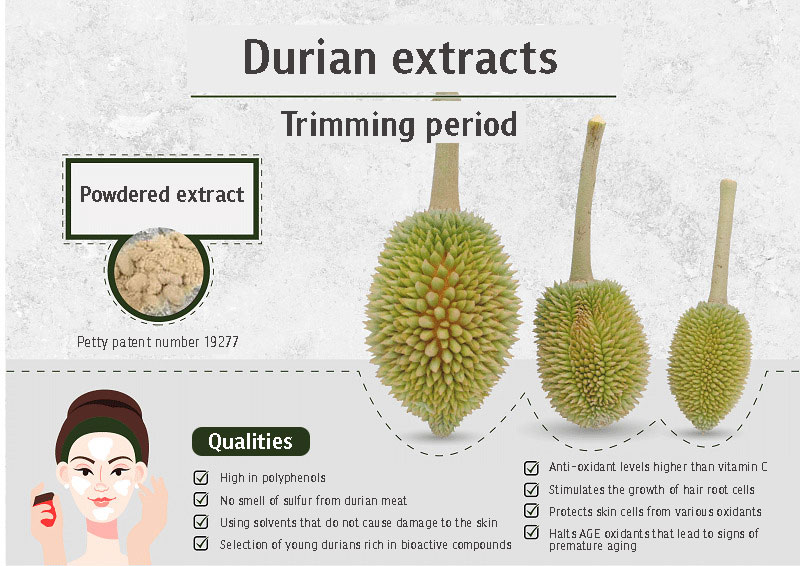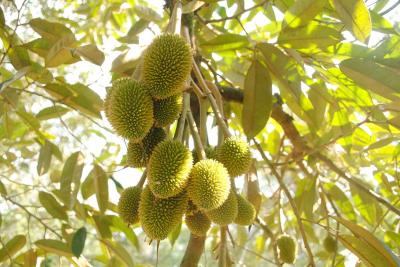
Anti-Oxidant Extracts from Young Durians at the Trimming Period Chula Research Team Aim to Produce Cosmetics Creating Value from Agricultural Waste
A team of researchers from Chula’s Faculty of Science has discovered extracts from young durians with as high anti-oxidants as vitamin C that help moisturize the skin with UV protection. They aim to produce skin care products as a way to help farmers to add value to their agricultural waste.
The durian has been called the king of fruits. It is vital to the economy since each year Thailand exports durians to various countries in the world bringing in a vast amount of income for the country as well as our growers. Unfortunately, there are also large numbers of durian fruits that have yet to be maximized to their full potential for any added value.
“Each durian tree usually bears numerous flowers which means that farmers need to trim off around 200-300 young durians per tree. The reason for this is that if all flowers yield fruits the tree will not be able to bear the weight and the branches will break. Growers need to select the fruits that have the potential to be fully grown and look appealing enough to fetch a good price.” Associate Professor Dr. Supaart Sirikantaramas of the Department of Biochemistry, Faculty of Science, Chulalongkorn University related how the research project originated with the idea to increase farmers’ income and maximize the use of biochemical resources under the BCG (Bio-Circular-Green Economy) policy for Bio-economy.
“There are vast areas of land devoted solely to the planting of durians which yield large numbers of fruits each year, yet raw materials deriving from the agricultural waste generated largely go to waste. We have, therefore, tried to find ways to increase the value of young durians found in various orchards by studying their biochemical composition to see how they could be adapted for further use.”
Vital elements in young durians
According to Associate Professor Dr. Supaart, young durians are the fruit of the durian (Durio zibethinus L.) at the stage of fruit trimming. The meat has not fully developed and the durian’s unique odor which has sulfuric content is yet to appear. At this stage, the fruit is 6-12 centimeters in length and produces a transparent slime similar to a snail’s slime inside the fruit when soaked in water.
“The team conducted a metabolome analysis (all metabolites) of the young durian to determine its chemical composition along with its biological activities. Polyphenols which are very high in anti-oxidants were found along with Phenolics with their ability to halt or delay oxidation which is the cause of oxidants and can create glycation that involves adding sugar to proteins as well as the ability to protect the skin from ultraviolet rays. Aside from that, pectin which keeps the skin hydrated was also found.”
Associate Professor Dr. Supaart further indicated that the various substances found in young durian can also be found in various types of fruits and plants such as grape seeds or cocoa but in different quantities.
Young durian extracts are good for the skin and the hair, odorless and safe
Putthamas Pewlong, a Master’s Degree student in Biochemistry at the Faculty of Science, Chulalongkorn University who is a member of the research team explained that extractions from the young durian with biomarkers are a straightforward extraction process that does not make use of toxic solvents that can affect consumers or the environment. The extraction also does not involve heat which helps reduce energy consumption, the process, and the cost involved. This extraction method brings about relatively high levels of antioxidants and pectin.
“Once we got the young durian extraction we tested it on the skin cells by dividing the cells and curing them in the extraction for 24 hours. We then add a cell that causes tension to create an effect that is similar to when we find dust or sunlight. The results showed that cells with a high level of young durian extraction contain large numbers of live cells. This means that when the cream is applied before being exposed to pollutants our skin gets more protection than not having applied any skin care. In comparison with vitamin C, it is found that young durian extracts have a similar level of protection if not higher since it contains a high level of antioxidants.”
Aside from its efficacy, the research time also tested toxicity on the skin and found that the extract has a positive effect and does not show toxics. This means that they are highly safe and hardly likely to cause allergic reactions and can therefore be used in cosmetics and skincare products.
“We tried taking sunscreen products on the market and mixed them with the extractions in powdered form at a level of 2-3% as determined by the FDA and found that the texture remained the same and even if the extract had a pale yellow color to it when added to the product was hardly visible. Most importantly there is no smell of durian which doesn’t interfere with the smell of the cream itself.”
Other than this, the research team also found that the extraction from young durian can affect an increase in cell divisions of hair roots which means that it has the potential of being adapted to diverse types of products in the future.
Young durian and value the future of added products
In the initial stage, the team researched vital extracts in the Mon Thong young durian. It later branched off to other types of durians and found that regardless of its type the young durian yielded similar levels of vital extracts. “In the future, when our research reaches the stage of commercial production, we believe we can increase the income of our growers so that they do not need to cut off and discard the young fruit but send them off to be produced as extracts for skin care products.”
Associate Professor Dr. Supaart concluded by saying that Thailand is rich in natural resources, especially in terms of agricultural products like fruits that are interesting and worthy of serious support for study and research that could be in the form of product processing, increasing the value of surplus raw materials as well as innovative developments.
Finally, the research team wishes to express its appreciation to other members of the team for their cooperation. This includes Associate Professor Manchumas Prousoontorn of CU Faculty of Science, Associate Professor Dr. Varisa Pongrakhananon CU Faculty of Pharmaceutical Science, Assistant Professor Nat Tansrisawad, M.D. CU Faculty of Medicine and Dr. Atchara Paemanee from the National Omics Center, NSTDA.
Those interested in young durian extracts for cosmetic purposes may contact Associate Professor Dr. Supaart Sirikantaramas at the Department of Biochemistry, Faculty of Science, Chulalongkorn University at Email: [email protected]
Source: ศูนย์สื่อสารองค์กร จุฬาฯ
